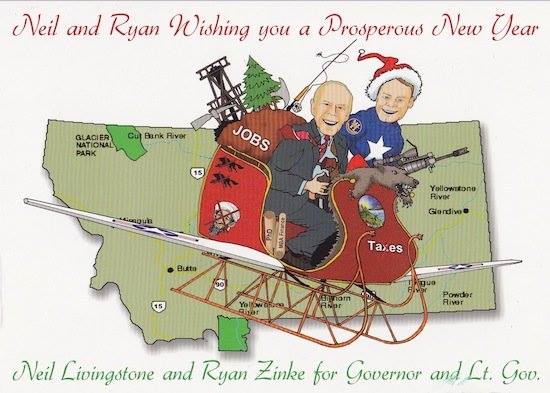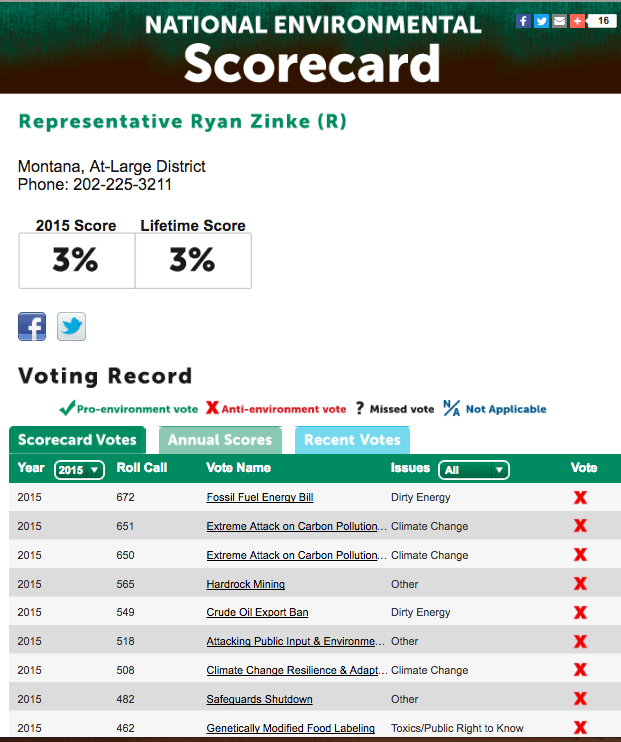
According to the Washington Post: “the fossil fuel industry is enjoying a remarkable resurgence as its executives and lobbyists shape President-elect Donald Trump’s policy agenda and staff his administration. The oil, gas and coal industries are amassing power throughout Washington — from Foggy Bottom, where ExxonMobil chief executive Rex Tillerson is Trump’s nominee to be secretary of state, to domestic regulatory agencies including the departments of Energy and Interior as well as the Environmental Protection Agency.”
Based on the number of Cabinet and upper Administration picks over the past few weeks it would not be a stretch to say that President-elect Trump is essentially building an America government for big oil and resource extraction industries, run by big oil and resource extraction industries.
Just yesterday, President-Elect Trump made his nomination of Montana Rep Ryan Zinke to head the Department of Interior official. If you care about America’s public lands, wildlife and wilderness heritage, the person in charge of the Dept of Interior is a big deal. After all, the Dept of Interior manages 1/5 of the entire land base in the U.S., 35,000 miles of coastlines and 1.76 billion acres of the Outer Continental Shelf.
If confirmed by the U.S. Senate, Ryan Zinke would be in charge of 70,000 employees and the following federal agencies and bureaus: Bureau of Indian Affairs, Bureau of Land Management, Bureau of Ocean Energy Management, Bureau of Reclamation, Bureau of Safety and Environmental Enforcement, National Park Service, Office of Surface Mining Reclamation and Enforcement, U.S. Fish and Wildlife Service and U.S. Geological Survey.
In my capacity as director of the WildWest Institute I issued the following statement yesterday:
Rep Ryan Zinke has an established track record of being pro-coal, pro-fracking, pro-logging, anti-science and anti-endangered species act when it comes to managing America’s public lands and wildlife. This has earned Zinke an environmental voting record of 3% from the League of Conservation Voters and a National Parks voting record of just 9% from the National Parks Conservation Association.
Let’s also not forget that Rep Zinke was just hand picked by President-elect Donald Trump, someone who is clearly assembling the most anti-environmental, anti-public lands, pro-oil and gas and pro-wall street cabinet and administration in U.S. History.
To think that Congressman Ryan Zinke is going to be a strong advocate for America’s public lands, our national parks and fish and wildlife species – and not just do the bidding of his boss, Donald Trump and campaign contributors in the resource extraction industry – is simply delusional, and not being honest with the American public.
Simply because someone has stated that they would not sell-off, or give away, America’s public lands, does not in any way make that person a huge public lands champion, or a “Teddy Roosevelt Republican” especially when the voting record clearly exposes the truth.
Here what some of the most mainstream and well-respect conservation, wildlife and environmental groups in the country had to say about Trump’s pick of Zinke:
Defenders of Wildlife says Zinke Poses Serious Threat to Wildlife Conservation (here)
Sierra Club criticizes Zinke nomination, strongly urges Senators to oppose nomination (here)
Natural Resources Defense Council: Zinke’s Record Falls Far Short and Adds to Trump’s Fossil Fuel Cabinet (here)
The Wilderness Society says “Trump Interior Nominee Ryan Zinke Raises Serious Concerns (here)
When President-elect Trump nominated Ryan Zinke yesterday, Trump issued the following statement: “[Ryan Zinke] has built one of the strongest track records on championing regulatory relief, forest management, responsible energy development and public land issues.”
Here’s what that strong track record looks like according to the very mainstream League of Conservation Voters. If you care about America’s public lands, wildlife and wilderness legacy…buckle up folks, because it’s going to be a bumpy ride.

Oh! My! The sky is falling!
Oh! My! Gil, are you seriously not paying attention to what’s happening in this country, and the world? Honestly, we may be lucky if only the sky does fall.
Anyway, specific to this post, I’d welcome your substantive feedback on Zinke’s voting record while in Congress, or the opinions expressed by myself and groups like Defenders of Wildlife, Sierra Club, The Wilderness Society and NRDC.
Matthew
Your post says that Trump says that Zinke is big on forest management. What you’ve posted about Zinke in earlier posts seemed to be a better approach than anything that you have espoused.
As you may have noticed, I tend to disagree with what you think is good for our federal forests based on my education and over 40 years of experience and following both the scientific and operational literature. So if you are against him, he’ll probably be good for the health of our forests.
Instead of fear mongering, please respond to the specific points in my post in another thread yesterday titled “In Search of Common Ground”. The established science is clear and if the science wasn’t being ignored, our national forests would be much healthier. So why should I get upset about Zinke when he can’t do anymore harm to our national forests than what has already been done since 1990 by those who don’t know the fundamental science essential to providing healthy forests in a manner that improves the of odds of sustaining both the forests and the species that depend on those forests to provide their habitat.
What you espouse isn’t working. Let’s leave politics out of this group and focus on Finding Common Ground by discussing the science and how said science can improve our federal forests as opposed to living in fear.
Sorry Gil, but I fear that I don’t live in fear nearly as much as you’d like to believe. Thanks for the comment though.
Anyone willing to compare former Secretary James Watt to Rep. Zinke? I’m not aware of Rep. Zinke’s policies, but I did live/work during the Watt tenure as Secretary of the Interior. I believe that much of what happened with the environmental movement in the late-1980s/early-1990s occurred in part due to what happened in the 1980s under the Reagan Administration.
GEORGE OCHENSKI: Zinke and the ghosts of Interior secretaries past
http://missoulian.com/news/opinion/columnists/george-ochenski-zinke-and-the-ghosts-of-interior-secretaries-past/article_279d7fe0-3c52-5517-88db-12ab601fe764.html
Gil says “…fundamental science essential to providing healthy forests in a manner that improves the odds of sustaining both the forests and the species that depend on those forests”. Based on his earlier invocation of established science, I infer that he argues for much of what we see in “commercial forestry.” With that as a starting point, I’d ask how one would explain the health of forests and super abundance of all manner of fish and wildlife circa 1850(ish) in the absence of such essential management. And no, I don’t want to hear about native Americans use of fire and other such activity.
We will need to have a comprehensive definition of “commercial forestry” before we go comparing it to USFS land management. What the Forest Service does in the Sierra Nevada is a far cry from what SPI does on their checkerboarded parcels on similar lands. Yes, the Forest Service sells trees which average 14-15″ in diameter, which makes it ‘commercial’. It is unfair to compare clearcutting to “Preservationism” when debating about public forests.
Yes, pre-European burning didn’t really cover all that much of the current Forest Service acreage. However, where they did practice it, there were profound changes to their landscapes. A pre-Man landscape just isn’t possible, so we need to discard those mindsets, regarding our forests.
Larry
Commercial as defined by Merriam-Webster is “occupied with or engaged in commerce or work intended for commerce”, “viewed with regard to profit” and “emphasizing skills and subjects useful in business”
Commerce is defined as “the exchange or buying and selling of commodities on a large scale involving transportation from place to place”
Can’t we say that if a forestry operation doesn’t remove a saleable product from the site it is non-commercial silviculture. Therefore, commercial forestry is one where a saleable product is produced for revenue or in exchange for other services in order to make a profit or at least offset some of the costs of a silvicultural treatment.
It seems simple to me. Any problem?
Jim
Regarding your statement: “I infer that he argues for much of what we see in “commercial forestry.””
Not really, I ague for whatever is needed to keep our federal forests healthy. That could include a commitment to long term commercial forestry where the scale is such that we need infrastructure in place to reduce the costs of maintaining healthy forests – if healthy forests are a desirable goal that we all can agree on.
Our efforts on the discussion thread titled: IN SEARCH OF COMMON GROUND is where we are trying to pin each of us down as to what we believe in an effort to find any common ground.
I have some questions for you that will help me to better understand where you are coming from in regard to what I infer to be your belief that “hands off”, “let nature do her thing” is always the best thing for our forests and those who want to “preserve” them.
1) Do you believe that the current state of all of our federal forests is acceptable and no human intervention is required for restoration, health, risk reduction or any other reason? If not, is there any place where human intervention is acceptable such as curtailing wildfires?
2) If you believe that human intervention is appropriate to save endangered forest dependent species, why do have a problem with intervening to provide the healthy forests upon which all forest dependent species depend?
3) Do you believe that our federal forest should be allowed to damage adjacent private forests and existing infrastructure as well as endanger human lives because of some preeminent need to let nature rule in our national forests regardless of the consequences?
4) How do you support the idyllic state of forests that you claim has existed everywhere in the US prior to 1850? Prior to the late 1600’s there were no reporters or even sufficient presence of populace on even the east coast to note that a million acres of contiguous forests burned here there and yonder prior to the 1850’s and prior to 1700 in either the west or the east coasts respectively and certainly not in the interior? Can you document that there were no salmon streams taken out of service for a given period of time by erosion caused by catastrophic fires, windstorms/hurricanes, insects or disease? Were there less lightning strikes back then? How did the 200 and 300 year droughts that California experienced between the birth of Christ and the 1850’s impact forest fires. Where are your records of fire acreage by year back for two millennia?
5) Do you agree that global warming requires more control over stand density to decrease the increased risk of loss of health from excessive drought brought on by global warming?
6) Do you know how many species went extinct in the US by century prior to the Indian’s arrival and since the Indian’s arrival?
Please answer these and provide any other thoughts that make your case. It would be helpful if you posted them in the “IN SEARCH OF COMMON GROUND” discussion thread. Your answers will either limit or expand the common ground.
That’s why I put commercial forestry in quotes; as an abbreviation for the many specifics of established science noted by Gil DeHuff. I’m simply trying to clarify and contrast results from managed (with “essential” science) and relatively unmanaged lands. And I assume we’re speaking about lands broadly, not just the Sierra Nevada.
Jim
Yes, we are speaking in general terms in respect to the fundamental science that underlies all forests.
In regard to your comment: “I’m simply trying to clarify and contrast results from managed (with “essential” science) and relatively unmanaged lands”. Please see my response to your 1st comment above.